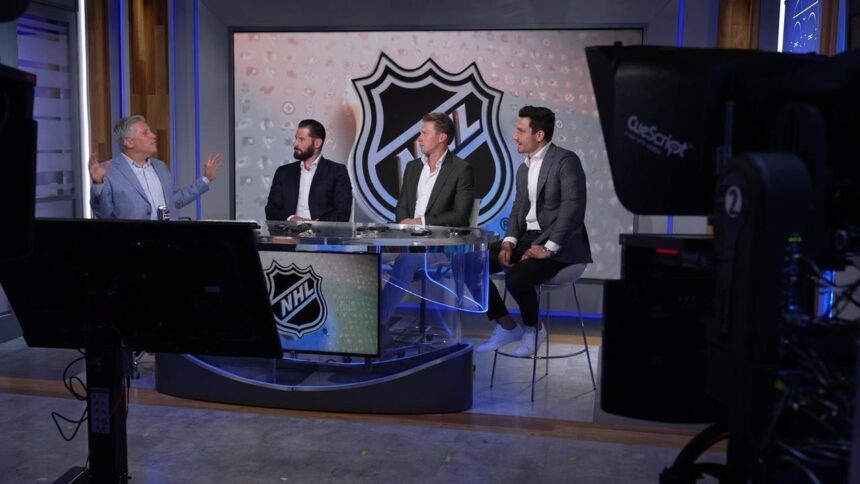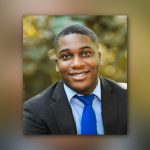NEW YORK — Erik Johnson and Garnet Hathaway each signed contracts with the Philadelphia Flyers on July 1.
But they’ve also spent time preparing for something beyond the upcoming NHL season.
Johnson and Hathaway were two of the nine current and recently retired players who took part in the first NHL Broadcast Training Camp at the NHL offices in Manhattan on July 17.
The all-day event featured modules geared toward game preparation and study, reporting, studio work, and social media and podcasting, with instruction from TNT lead play-by-play voice Kenny Albert and analysts Eddie Olczyk and Brian Boucher, ESPN studio host and play-by-play voice Steve Levy, and Philadelphia Flyers studio host Ashlyn Sullivan.
“The more years that I’ve been playing and knowing that inevitably I’m going to stop playing at some point, I don’t think there’s any problem with trying to figure out what interests me after hockey,” Hathaway said. The 32-year-old signed a two-year, $4.8 million contract ($2.4 million average annual value) that begins with the 2025-26 season. “I think the big thing for me is, will it be in hockey or will it not be? So, this is an awesome opportunity to see what the other side is.”
Johnson, 36, signed a one-year, $1 million contract to play his 17th NHL season. After 987 regular-season games and 55 in the Stanley Cup Playoffs, he understands the grind that comes with being an NHL player.
What he learned is that the broadcasting side brings its own challenges that can be just as difficult to manage.
“The biggest thing for me would be all the notes and research that goes into this,” Johnson said. “You talk to them and if they’re doing a Dallas-Edmonton [game], they’re watching that team’s previous two games to get ready, to prep for that current game. They have years and years of notes and stats. To say they’re professionals is probably an understatement.”
Levy said player engagement was high during his programs, with several questions centered on how he works while wearing an IFB, the wired earpiece that allows him to communicate with producers.
“The IFB, that squiggly wire, the cord, that looks scary,” he said. “I see them all staring out of the corner their eye, ‘What am I doing with that? I’ve got to put that in my ear? What’s that going to feel like? Wait, somebody’s talking to me while I’m also talking?’ I feel like that’s the thing that throws them off maybe a little bit, and that is one of the biggest skills in our business. That’s an acquired skill that takes repetition, takes some getting used to.”
Olczyk said one of the concerns raised by players during his classes were how they appeared during a broadcast.
“It’s not the conversation itself, it’s what do I do with my hands?” he said. “Where am I sitting? Should I have notes in front of me or not have notes in front of me? Where do I look? Do I look at the camera?
“This aspect is two very different things. There’s hockey, and then there’s the broadcast aspect. And in our case, the broadcast is probably more important than the hockey. They already know the hockey, so we’re trying to help them out with the broadcast end. You really need to be good at both to make for a good show.”
Also taking part were Colorado Avalanche forward Chris Wagner, New York Rangers goalie Louis Domingue, and former players Devante Smith-Pelly, Nate Thompson, Michael Del Zotto, Darius Kasparaitis and Ryan Kesler.
“We went to our clubs and we looked for candidates, players who may want to transition into broadcasting hockey as one avenue of kind of post-career opportunity, as part of a broader umbrella for us of providing player development resources so players can start thinking about life off the ice and what follows their hockey careers,” NHL Deputy Commissioner Bill Daly said.
The NHL’s player development efforts have existed since 2013 with the creation of the NHL/NHLPA Player Orientation Program. The League also has off-ice player development directors with all 32 teams who help administer the League’s resources, which in addition to the Broadcast Training Camp, include career and education guidance through AthLife and the NHL Visiting Player Program, as well as placement assistance for the Fanatics Athlete Immersion Program and the NHL Coaches’ Global Clinic.
The Broadcast Training Camp, however, allows for players to learn what it would take for them to stay in the game in a more public way.
“This whole process has a dual purpose,” NHL Commissioner Gary Bettman said. “One, it gives players, former players, something to focus on as to their next career. And it keeps them close to the game, which is important to the players. But at the same time, having an opportunity to have a new group of broadcasters who are close to the game, have a unique perspective on the game, is another way for our fans to be connected to the game and get new and different insights from the perspective of a former player.”
Bettman said he hoped members of the inaugural class would spread the word about the value of Broadcast Training Camp.
It certainly earned the support of Del Zotto, who played for eight teams during 13 NHL seasons, most recently with the Ottawa Senators in 2021-22.
He said if any of his former teammates were given the chance to take part, he would tell them to go for it.
“I’d say it’s a no-brainer,” he said. “It’s a positive experience. They should get here. It’s a great learning experience.”










